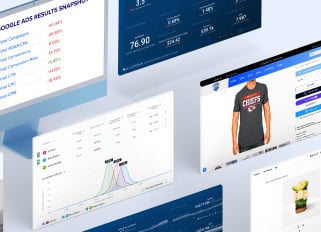
Google Ads for Ecommerce Websites: Best Practices, Tips & Examples
Navigating the world of Google Ads can be a game-changer for your ecommerce business. With the right ecommerce Google ads strategies, you can drive high-quality traffic to your site, increase conversions, and ultimately boost your sales.
This blog post dives deep into the best practices, tips, and examples of Google Ads for ecommerce websites. Whether you’re a digital marketer or an ecommerce entrepreneur, this comprehensive guide will equip you with the insider knowledge needed to excel in your ad campaigns.
Why Google Ads Matter for Ecommerce Websites
Google Ads are a potent tool for ecommerce businesses. They allow you to reach potential customers precisely when they’re searching for products like yours. Unlike other forms of advertising, Google Ads targets people with high intent through Google Search, making them more likely to convert into paying customers.
Here are the top reasons why Google Ads are crucial for ecommerce websites:
Increase Brand Visibility
One of the primary benefits of Google Ads is increased brand visibility. By appearing at the top of search results, your brand gains exposure to a wider audience. This heightened visibility can lead to higher click-through rates and more sales.
Additionally, the Google Display Network, with its reach of over 2 million websites and applications, is crucial in increasing brand visibility through various ad formats and effective retargeting efforts.
Target High-Intent Customers
Google Search Ads enable you to target customers based on their search queries, demographics, and even past behavior. This level of targeting ensures that your ads reach people who are already interested in products like yours, increasing the likelihood of conversion.
Cost-Effective Advertising
Google Ads operate on a pay-per-click (PPC) model, meaning you only pay when someone clicks on your ad. This makes it a cost-effective way to drive traffic to your ecommerce site. You can achieve a high return on investment (ROI) with proper optimization.
What Do the Experts At Bluetuskr Recommend?
- Try this: Focus on long-tail keywords to target specific customer queries. This will reduce competition and lower your cost-per-click (CPC).
- Try this: Continuously monitor and adjust your bids based on performance to maximize your ROI.
- Try this: Use ad extensions like sitelinks and callouts to provide more information and increase your ad's click-through rate (CTR).
Setting Up Your Google Ads Campaign
Setting up a successful Google Ads campaign involves several critical steps. Setting up a Google Ads account is a foundational step for any advertising campaign. From keyword research to ad creation, each phase plays a vital role in your campaign’s success.
Conduct Comprehensive Keyword Research
Keyword research is the foundation of any Google Ads campaign. Identify keywords that are relevant to your products and have a high search volume. Use tools like Google Keyword Planner to find the best keywords for your campaign.
Structuring search campaigns based on comprehensive keyword research is crucial for targeting different stages of the customer journey and optimizing ad performance.
Create Compelling Ad Copy
Your ad copy is what will draw potential customers to your site. Make sure it’s compelling, relevant, and includes a clear call-to-action (CTA). Highlight the unique selling points of your products to make your ads stand out.
Optimize Landing Pages
The landing page is where your potential customers will end up after clicking your ad. Ensure that it’s optimized for conversions. This means having a clean design, fast load times, and a clear CTA.
What Do the Experts At Bluetuskr Recommend?
- Try this: Use negative keywords to filter out irrelevant traffic and save on ad spend.
- Try this: A/B test different versions of your ad copy to see which performs better.
- Try this: Ensure your landing pages are mobile-friendly, as a significant portion of traffic comes from mobile devices.
Leveraging Google Shopping Ads
Google Shopping Ads, through various shopping campaigns, are a powerful way to showcase your products directly in search results. These ads display product images, prices, and other essential details, making them highly effective for ecommerce.
Create a Google Merchant Center Account
To run Google Shopping Ads, you need a Google Merchant Center account. This platform allows you to upload your product data, which Google uses to create your shopping ads.
Organizing your products into ad groups within the Google Merchant Center is crucial for managing different campaign types efficiently, ensuring that ads are relevant to specific keywords and product pages.
Optimize Product Listings
Ensure your product listings are optimized with high-quality images, accurate descriptions, and competitive pricing. This will improve your ad’s performance and increase the likelihood of conversions.
Monitor and Adjust Bids
Regularly monitor your bids and adjust them based on performance. Higher bids can improve your ad’s visibility, but be mindful of your budget to ensure a good ROI.
What Do the Experts At Bluetuskr Recommend?
- Try this: Use high-quality, professional images to make your products stand out.
- Try this: Include detailed and accurate product descriptions to build trust with potential customers.
- Try this: Set up automated bidding strategies to optimize your bids based on your campaign goals.
Using Remarketing to Re-Engage Customers
Remarketing is a crucial strategy for ecommerce businesses. It allows you to target users who have previously visited your site but didn’t make a purchase.
Set Up Remarketing Lists
Create remarketing lists based on user behavior on your site. For example, you can target users who viewed a specific product but didn’t add it to their cart.
Craft Personalized Ads
Personalized ads are more effective in re-engaging customers. Use dynamic remarketing to show users ads featuring the exact products they viewed on your site.
Monitor and Refine Your Strategy
Regularly monitor the performance of your remarketing campaigns and make adjustments as needed. This will help you maximize your ROI and improve your overall campaign performance.
What Do the Experts At Bluetuskr Recommend?
- Try this: Offer special discounts or promotions in your remarketing ads to entice users to return.
- Try this: Use frequency capping to avoid overwhelming users with too many ads.
- Try this: Segment your remarketing lists based on user behavior to deliver more personalized ads.
Measuring and Analyzing Campaign Performance
Measuring and analyzing the performance of your Google Ads campaigns is crucial for ongoing success. Use Google Analytics and other tools to track key metrics and make data-driven decisions.
Track Key Metrics
Monitor metrics like CTR, conversion rate, and cost-per-conversion to gauge the performance of your campaigns. These metrics will help you understand what’s working and what needs improvement.
 Perform A/B Testing
Perform A/B Testing
A/B testing is a valuable technique for optimizing your campaigns. Test different ad copies, landing pages, and bidding strategies to see which ones yield the best results.
Adjust Campaigns Based on Data
Use the insights gained from your analysis to make informed adjustments to your campaigns. This could involve tweaking your ad copy, adjusting your bids, or refining your targeting.
What Do the Experts At Bluetuskr Recommend?
- Try this: Set up conversion tracking to measure the ROI of your campaigns accurately.
- Try this: Use heatmaps to analyze user behavior on your landing pages and make necessary adjustments.
- Try this: Regularly review your search terms report to find new keywords and negative keywords.
Best Practices for Google Ads Success
Following best practices can significantly improve the success of your Google Ads campaigns. Here are some tried-and-true tips to help you get the most out of your advertising efforts.
Keep Your Campaigns Organized
Organized campaigns are easier to manage and optimize. Group similar keywords and ads into ad groups to keep everything structured and efficient.
Use Ad Extensions
Ad extensions provide additional information and increase the visibility of your ads. Use site links, callouts, and structured snippets to enhance your ads and improve your CTR.
Regularly Review and Optimize
Google Ads is not a set-it-and-forget-it platform. Regularly review your campaigns and optimize them to ensure ongoing success. This includes adjusting bids, refreshing ad copy, and updating keywords.
What Do the Experts At Bluetuskr Recommend?
- Try this: Use geographic targeting to focus your ads on regions where your products are in high demand.
- Try this: Implement a seasonal strategy to capitalize on holidays and special events.
- Try this: Use audience targeting to reach specific segments of your customer base.
Advanced Strategies for Maximizing ROI
For those looking to take their Google Ads campaigns to the next level, advanced strategies can help you maximize your ROI. These strategies require a deeper understanding of Google Ads and a commitment to continuous optimization.

Implement Dynamic Search Ads
Dynamic Search Ads automatically generate ads based on the content of your website. This can help you capture additional traffic and improve your ad relevance.
Use Automated Bidding Strategies
Automated bidding strategies use machine learning to optimize your bids in real-time. This can help you achieve your campaign goals more efficiently and effectively.
These strategies are particularly effective for optimizing video ads and enhancing their performance on platforms like YouTube and the Google Display Network.
Leverage Customer Match
Customer Match allows you to target ads to specific customers based on their email addresses. This is a powerful way to re-engage existing customers and encourage repeat purchases.
What Do the Experts At Bluetuskr Recommend?
- Try this: Use dynamic search ads to capture long-tail keywords that you might have missed.
- Try this: Experiment with different automated bidding strategies to find the one that works best for your campaign.
- Try this: Use Customer Match to create highly personalized ads for your most valuable customers.
- Try this: Leverage YouTube Ads to target specific audiences and drive eCommerce success.
Conclusion
Mastering Google Ads for ecommerce websites requires a mix of strategic planning, continuous optimization, and a deep understanding of your target audience. By following the best practices, tips, and examples outlined in this guide, you’ll be well on your way to creating successful Google Ads campaigns that drive traffic, increase conversions, and boost your sales.
Ready to take your Google Ads to the next level? Interested in e-commerce Google Ads services? Contact our team at Bluetuskr, an e-commerce marketing agency for expert guidance on optimizing your campaigns for maximum ROI.
Connect With Us
Recent Post

.png)





Tell us what you think!